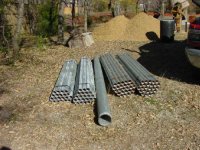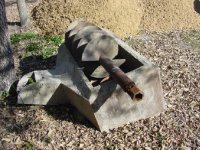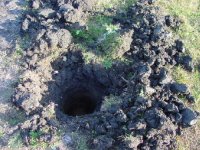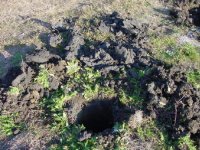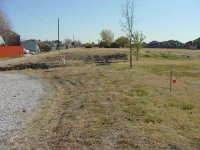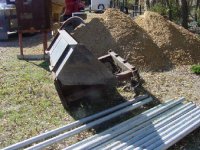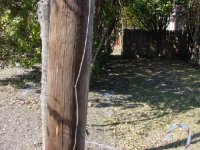wroughtn_harv
Super Member
Not all of us have to worry about frost heave. /forums/images/graemlins/grin.gif
Here we do have clay heave. I have a bud who lives on a hill in Rockwall County. He claims his elevation changes two to three inches between our wet and dry seasons.
My reputation is based upon straight fences. Straight fences years later. The biggest difference between me and all the other guys is the amount of concrete I use as far as I can tell.
Look at it this way. Here we use a lot of pipe for posts and rails. I can buy new two and three eighths that has a wall thickness just on the edge of being schedule forty for about eighty to eighty five cents a foot. That's relatively heavy pipe for fencing for next to nothing. I get full weight schedule forty galvanized for about fifty percent more.
If you take a two and three eighths post and just tamp it in you have a little less than a two and half inch cross section resisting lean. If you have the kind of concrete footer I use, twelve to thirteen inches in diameter and three feet plus in depth. You have a much wider cross section resisting lean.
The other posters here from north Texas can confirm that seeing a straight pipe fence that's been up over two years is a rarity. They might have looked perfect when they were installed but after a couple of seasons they're friendlier than poor relatives. They wave just thinking you're noticing.
I see the reasons for the fences bouncing up and down and in and out after a couple of years strictly from taking shortcuts in setting the posts.
If the hole is dug but not cleaned out then you have fluffy stuff in the bottom of the hole that will compress over time, especially when it gets wet. When that happens the post settles.
If the concrete is a glob at the top of the hole then the wet heave will pop it out of the ground like a teen doing a blackhead. You have a post rising.
The pipe itself expands and contracts at a different rate than the soil it's in. The easiest direction for it to expand is sideways. Especially if the concrete footers are small. And what never seems to happen is it contracting back. /forums/images/graemlins/smirk.gif
A popular remedy for this is to have slip joints. They work good for the problem encountered when butt welds brake. But they don't do squat for fence weave up or down.
I've never installed a slip joint. I've never had a butt joint fail in a fence line either.
BTW one of the straightest fences in Parker Texas is at least fifteen years old. It was installed by a construction company, not a fence contractor. It's still dead on straight and I have to believe it's all about the good welding and great footers. It's nice to see someone else prove me right. /forums/images/graemlins/smirk.gif
</font><font color="blue" class="small">( In fact, all that concrete would be a real problem when you want to change your mind. )</font>
Almost all of my customers choose me and my methods because they want to put in the last fence on that property. /forums/images/graemlins/grin.gif
I'm not the person to give advice on fences going in where the freeze zone is below two feet. I'm a warm blooded animal. /forums/images/graemlins/grin.gif
Here we do have clay heave. I have a bud who lives on a hill in Rockwall County. He claims his elevation changes two to three inches between our wet and dry seasons.
My reputation is based upon straight fences. Straight fences years later. The biggest difference between me and all the other guys is the amount of concrete I use as far as I can tell.
Look at it this way. Here we use a lot of pipe for posts and rails. I can buy new two and three eighths that has a wall thickness just on the edge of being schedule forty for about eighty to eighty five cents a foot. That's relatively heavy pipe for fencing for next to nothing. I get full weight schedule forty galvanized for about fifty percent more.
If you take a two and three eighths post and just tamp it in you have a little less than a two and half inch cross section resisting lean. If you have the kind of concrete footer I use, twelve to thirteen inches in diameter and three feet plus in depth. You have a much wider cross section resisting lean.
The other posters here from north Texas can confirm that seeing a straight pipe fence that's been up over two years is a rarity. They might have looked perfect when they were installed but after a couple of seasons they're friendlier than poor relatives. They wave just thinking you're noticing.
I see the reasons for the fences bouncing up and down and in and out after a couple of years strictly from taking shortcuts in setting the posts.
If the hole is dug but not cleaned out then you have fluffy stuff in the bottom of the hole that will compress over time, especially when it gets wet. When that happens the post settles.
If the concrete is a glob at the top of the hole then the wet heave will pop it out of the ground like a teen doing a blackhead. You have a post rising.
The pipe itself expands and contracts at a different rate than the soil it's in. The easiest direction for it to expand is sideways. Especially if the concrete footers are small. And what never seems to happen is it contracting back. /forums/images/graemlins/smirk.gif
A popular remedy for this is to have slip joints. They work good for the problem encountered when butt welds brake. But they don't do squat for fence weave up or down.
I've never installed a slip joint. I've never had a butt joint fail in a fence line either.
BTW one of the straightest fences in Parker Texas is at least fifteen years old. It was installed by a construction company, not a fence contractor. It's still dead on straight and I have to believe it's all about the good welding and great footers. It's nice to see someone else prove me right. /forums/images/graemlins/smirk.gif
</font><font color="blue" class="small">( In fact, all that concrete would be a real problem when you want to change your mind. )</font>
Almost all of my customers choose me and my methods because they want to put in the last fence on that property. /forums/images/graemlins/grin.gif
I'm not the person to give advice on fences going in where the freeze zone is below two feet. I'm a warm blooded animal. /forums/images/graemlins/grin.gif
